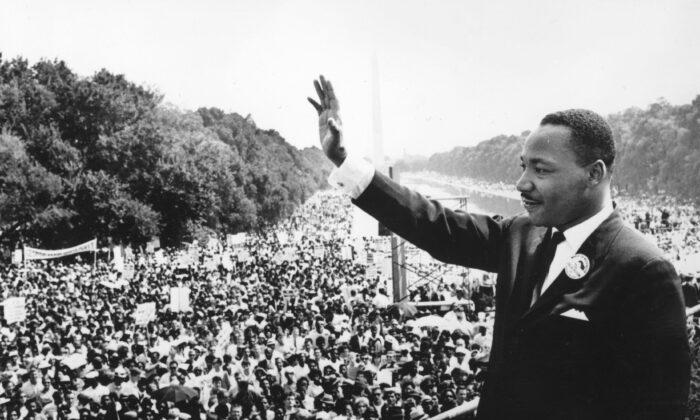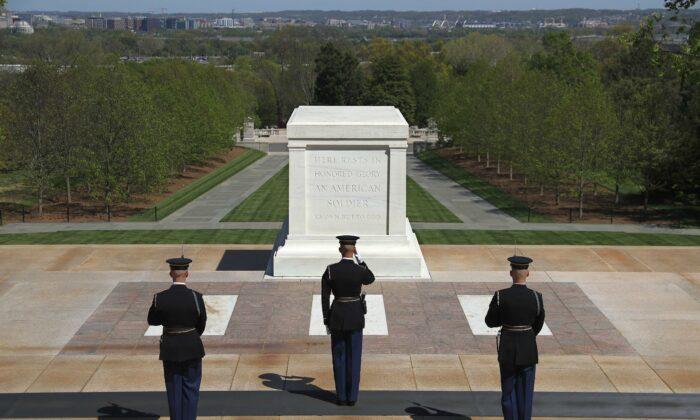Why should Americans oppose the decision of the now-disbanded Congressional Naming Commission to remove from Virginia’s Arlington National Cemetery the Moses Ezekiel Reconciliation monument—one of the greatest works of art in that hallowed ground?
Two contemporary strategic reasons to oppose removal are that such an act validates the communist agenda to erase Americans’ connection with their virtuous history and destroy the American military fighting capability.
That radical agenda was accelerated by the COVID-19 lockdowns of 2020 and the death of George Floyd. That’s when urban rampages swept through the country, with unprecedented property destruction, orchestrated by far-left groups. Targets for destruction then shifted to American heritage monuments—first, the statues of Christopher Columbus, who discovered and opened the Americas, and then came the toppling of Confederate leaders.
So determined and organized are the radical America-hating history destroyers that in many states, there are now no monuments or statues of Columbus or Confederate Civil War heroes left standing. This partial erasure of history won’t appease the powers leading the radical assault on America from within. They fully intend to take down the Founders next and then the United States itself.
So it’s time to take a stand and put an end to this subversion and destruction. And it turns out that the Moses Ezekiel Reconciliation monument in Arlington National Cemetery is just the place to stand our ground, fight, and win.
First, consider the fact that Arlington Cemetery is inextricably linked to the families of George Washington and Robert E. Lee. Arlington House was built on the 1,100-acre plantation by Lee’s father-in-law, the adopted son of Washington, as a shrine to his father, the beloved first U.S. president. The Arlington House plantation was later inherited by his daughter Mary Custis, wife of Robert E. Lee, a man morally opposed to slavery. Lee was able to finalize the legal process that freed the 169 plantation slaves—while carrying out his wartime leadership military duties—before President Abraham Lincoln’s Emancipation Proclamation.
After President Lincoln mobilized 75,000 troops to fight against South Carolina and six other states’ secession—a right established in the original Constitutional Convention and discussed at various times by other prominent leaders—Virginia chose to secede from the Union in April 1861. The Lee family was compelled to leave Arlington House days before the U.S. Army occupied the estate. Part of that property became a burial ground for fallen soldiers early in the Civil War. By 1864, the Lincoln administration ordered that the Arlington plantation grounds be set aside as a national cemetery for the military. Thus, from the property of Robert E. Lee originated the most hallowed ground in America—the final resting place for veterans who gave in full measure fighting for the cause as they saw it: allegiance to ideals of freedom and self-determination.
Thirty-four years later, in 1898, the Spanish–American War erupted. Former Confederate soldiers, many adult children of Confederate veterans, and several Confederate generals, such as “Fighting Joe” Wheeler, fought alongside “Yankee” soldiers from northern states, bringing a swift American victory in Cuba and the defeat of Spain in just a few months. The contribution of the former Confederates now fighting under the U.S. flag was instrumental in establishing America as a “superpower” on the world stage.
President William McKinley, a Union army veteran, recognized this healing and solidarity that led to victory in the Spanish–American War. Addressing the nation, he pronounced: “Sectional feeling no longer holds back the love we bear each other. ... The Union is once more the common altar of our love and loyalty, our devotion and sacrifice.”
In June 1900, President McKinley supported a bill to establish a Confederate section in Arlington Cemetery. Connecticut Sen. Joseph Hawley, a Union veteran, worked with Confederate Gen. Marcus Wright to reinter some 260 Confederate bodies from various burial places to a designated section of Arlington Cemetery. In 1906, Secretary of War William Taft was given authority to erect a monument of reconciliation in that burial area, Section 16.
Moses Jacob Ezekiel, a world-renowned American sculptor, the first Jewish cadet at Virginia Military Institute who served in the Confederate army, was chosen to create a monument to capture the spirit of reconciliation, memorialize hundreds of soldiers buried in Section 16, and be recognized as a “Peace Monument” in Arlington, commemorating the reunification of the North and South.
Two years later, President Wilson unveiled the completed monument “to declare this chapter in the history of the United States closed.” Further, he said that “it is our duty and our privilege to be like the country we represent and ... stand shoulder to shoulder to lift the burdens of mankind in the future and show the paths of freedom to all the world.”
Fast forward to today, the removal of the Moses Ezekiel Reconciliation monument from Arlington Cemetery, which was conceived and blessed by three U.S. presidents, wouldn’t only dishonor those presidents; it would also dishonor the veterans of the Union and Confederate armies who came together in reconciliation. Those people, having closer proximity to bitterness and conflict, had more animosity between them, yet they chose the nobler path of reunification and reconciliation.
That today’s U.S. military leadership would participate in undoing that and preside over taking down one of the greatest American heritage monuments and reopen the wounds of the past on settled matters is deeply disturbing—and aligned with the communist agenda to use race warfare to divide and destroy America.
The Arlington Reconciliation monument is, in fact, a time capsule carrying valuable historical lessons from the past. Those lessons include showing us how former foes in a war over interpretations of the Constitution and states’ rights settled their differences on the battlefield, then worked through the difficulties of Reconstruction, and finally found magnanimity to reconcile and erect memorials commemorating what was noble and good.
The Department of Defense under Secretary Lloyd Austin continues steps toward removing the monument from Arlington. One of those necessary steps was holding a public meeting on Aug. 23 to assess the environmental impact of removal. In that four-hour meeting, more than 100 citizens from diverse states thoughtfully expressed their disapproval and revulsion of the memorial’s removal. Several commented that dramatic shortfalls in military recruiting are the direct result of acute dishonor inherent in the removal of the monument. One wounded warrior from the Iraq conflict who had suffered from PTSD gave a moving testimony of his healing that came about over weeks of visiting and praying at the memorial. Only a single participant favored removal.
The Reconciliation monument was Moses Ezekiel’s last and greatest work. Removal of this monument is profanely sacrilegious, illegal, and could be seen as antisemitic. It was also the culmination of his life’s work, showing reconciliation through the artistic genius of dramatic high-relief figures around the monument drum base and a female figure at the top turning a sword into a plowshare.
Elected office holders and military leaders who would disturb such a profound memorial headstone that embodies the essence of American ideals of tolerance and unity—the “e pluribus unum”—are in violation of the spirit of the oath of office, to which they pledged allegiance.
This profound and sacred monument should be left untouched so that it can continue to speak for itself to present and future generations.








